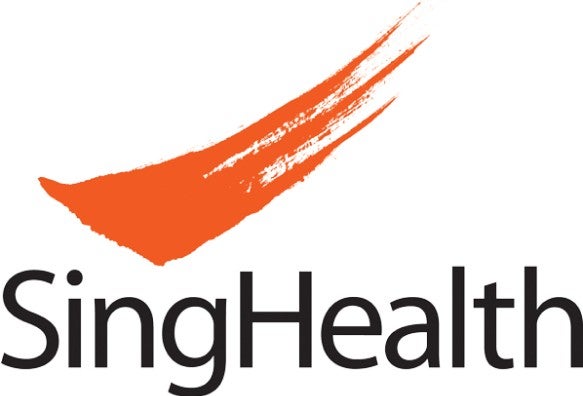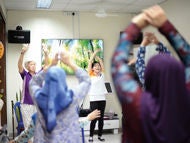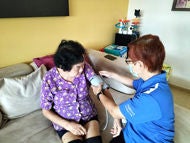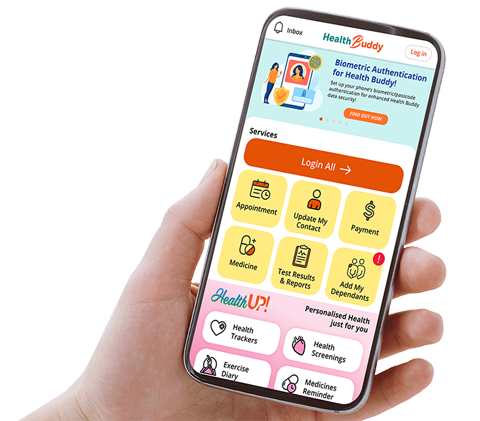What is - Restless Legs Syndrome and Periodic Limb Movements in Sleep

What are restless legs syndrome and periodic limb movements in sleep?
Restless legs syndrome (RLS) is a sensory-motor neurological disorder that causes an overwhelming urge to move the legs. It often begins at a very young age but is mostly diagnosed in the middle or later years.
When an involuntary twitching or jerking of the legs occurs during sleep, it is known as periodic limb movements in sleep (PLMS).
The prevalence of RLS in the United States and Europe is quoted to be around 7-10%, whereas in Asia, it is reported to be around 1-4%. Although it appears to be less common in Asia than in Europe and US, it is more likely under-reported. A local study done in Singapore showed a RLS prevalence of less than 1%. It is more common in women.
80% of RLS patients have PLMS. PLMS is usually picked up incidentally on overnight sleep studies. It is only clinically significant if it causes symptoms.
What are the types of restless legs syndrome?
RLS can be categorised as early-onset and late-onset. Early-onset RLS occurs below the age of 45 and late-onset RLS occurs above 45. Early onset may be due to a hereditary possibility, but other causes are also possible if there is no family history.
RLS can also be divided into primary or secondary types, with primary RLS being of unknown origin and secondary RLS due to a predisposing cause.
What are the potential complications of restless legs syndrome and periodic limb movements in sleep?
RLS can affect your quality of life. Both RLS and PLMS can disturb sleep by causing sleep-initiation insomnia and sleep maintenance insomnia respectively.
Symptoms of Restless Legs Syndrome and Periodic Limb Movements in Sleep
What are the symptoms of restless legs syndrome?
The main symptom a person may feel is the irresistible urge to move the legs when resting, to be relieved of the symptoms. Before this urge, there may be a creeping feeling (like an insect crawling from the feet upwards). It can affect the arms occasionally.
Commonly, the symptoms are worse in the evenings or night, but they can occur at any time of the day. The symptoms are relieved by moving the legs.
The symptoms are worse at rest.
When should you see a doctor?
If symptoms are severe and affecting one’s lifestyle or sleep, seeking medical advice to be evaluated may be useful.
RLS can be a constant annoyance in a person’s life, but treatment can help manage symptoms, make one feel better and assist in developing a regular sleeping routine.
How do restless legs syndrome and periodic limb movements affect your sleep?
If the symptoms are mild and short-lasting, the person’s sleep may not be disturbed. However, when they become severe, RLS can affect sleep and wake one up repeatedly, causing the person to get up and move or walk around the bed. This may lead to poor sleep if it occurs frequently. In uncommon situations, the person may be apprehensive of going to sleep.
Serious symptoms of RLS can affect quality of life and lead possibly to depression. There may be excessive daytime sleepiness leading to napping in the day. But this may also be difficult if RLS symptoms interfere with trying to sleep.
Restless Legs Syndrome and Periodic Limb Movements in Sleep - Causes and Risk Factors
What causes restless legs syndrome?
Early-onset RLS
This usually occurs before the age of 45 and is thought to be hereditary. However, this does not exclude other causes if there is no family history suggestive of RLS in any members. Early onset is generally slowly progressive in nature.
In females, RLS may manifest during pregnancy. It usually occurs in the last trimester and disappears after delivery.
Late-onset RLS
This usually occurs after the age of 45. It can have no family history and no known predisposing cause. It tends to progress rapidly and can be severe.
Women going through the perimenopausal phase may sometimes experience RLS.
Causes and risk factors of late-onset RLS include:
- Idiopathic in nature: There is no known or predisposing cause
- Iron-deficiency anaemia: Replacement of iron helps alleviate the symptoms
- Kidney failure and on dialysis:Especially in the initiation phase
- Thyroid disease: Overactivity of the gland can sometimes provoke RLS
- Parkinson’s disease: There is an increased risk for RLS
- Lesser-known causes: Such as osteoporosis which can present with RLS
What are the triggers for restless legs syndrome and periodic limb movements?
The following do not cause RLS but can make it worse.
Some medications that can potentially can do this are:
- Antidepressants
- Antipsychotics
- Lithium
- Antihistamines
Other possible triggers include:
- Excessive caffeine or alcohol
- Smoking
- Stress
- Obesity
- Anti-nausea drugs
Diagnosis of Restless Legs Syndrome and Periodic Limb Movements in Sleep
How is restless legs syndrome diagnosed?
There is no test to diagnose RLS. The diagnosis of RLS lies entirely on clinical features. A good history and neurological examination and blood tests help confirm the diagnosis.
- The symptoms mentioned above, a good medication history and family history are important.
- An evaluation of the symptom frequency, duration and intensity is important in the diagnosis and whether treatment is required.
- Blood tests may help to rule out other conditions that can cause RLS symptoms.
How are periodic limb movements in sleep diagnosed?
PLMS may be seen in a person with RLS, and can be as high as 80% in some studies, but only a minority of patients with PLMS may have RLS.
PLMS is usually picked up incidentally during sleep studies, and it is significant only if it causes symptoms.
How is restless legs syndrome diagnosed in children?
Diagnosing RLS in children may be difficult as they may not be able to describe their symptoms. Their symptoms can be misdiagnosed as ‘growing pains’ or attention deficit hyperactivity disorder (ADHD).
Words and phrases such as ‘ticklish’ or the feeling of ‘bugs crawling’ on them are some of the ways children may describe their symptoms.
RLS can affect their cognition and behavior. They may have difficulty going to sleep or awaken often, tossing and turning, and appear restless. Their legs may be observed by other family members to jerk during sleep.
They may be tired and listless in the day and irritable. A change of behavior may also be seen.
Treatment for Restless Legs Syndrome and Periodic Limb Movements in Sleep
How is restless legs syndrome treated?
To manage RLS and PLMS, maintain good sleep hygiene, quit smoking and exercise regularly during the day.
The mainstay of treatment is non-pharmacological first, and then pharmacological if the former is not successful.
Non-pharmacological treatment
- Good sleep hygiene – reduce stimulating activities, avoid caffeine or alcohol, keep regular sleeping hours
- Avoid exercising near or after 5 to 6 pm, but exercising moderately and consistently before then
- A trial of either hot milk, milo or honey at bedtime may be helpful
- Massages, soaking legs in warm water or using hot or cold packs can sometimes provide temporary relief
- Using foot wraps or vibration pads at the back of the legs may sometimes be helpful
- Muscle stimulators
- Treating primary disease adequately
Medications
- Iron supplements: Common cause, especially in the menstruating females
- Opioids: For severe RLS that does not respond to other treatments
- Benzodiazepines: Can help treat and manage insomnia, anxiety and muscle spasms that sometimes occur with RLS
- Dopaminergic agents: Drugs such as Carbidopa/Levodopa can help, but long-term use may worsen symptoms
Drowsiness is a common side effect for the opioids, benzodiazepines and dopaminergic agents, so caution is required in driving or using tools to operate heavy machinery.
Opioids and dopaminergic agents can cause dizziness and nausea at times.
Contributed by
The information provided is not intended as medical advice. Terms of use. Information provided by SingHealth.
Condition Treated At
Department
Sleep Disorders
Department
Respiratory & Critical Care Medicine
Department
Sleep Medicine, Surgery & Science
Department
Department of General Medicine




















